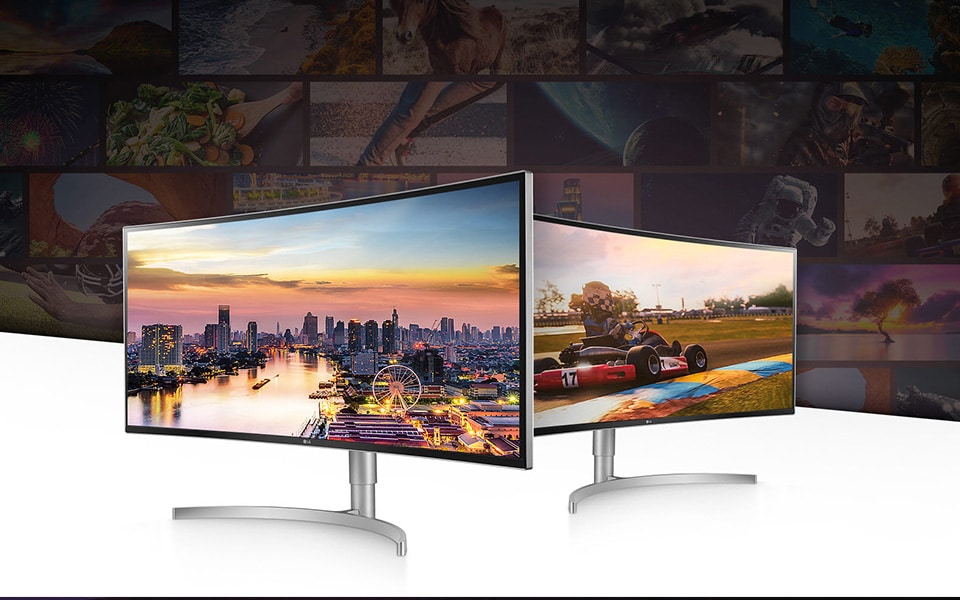Curved Monitors vs. Flat Monitors
1st November 2022

It’s no secret that a separate monitor can really enhance your gaming experience. When you’re looking for a gaming monitor, one of the first things you’ll probably be thinking about is whether to choose one with a curved screen or opt for a flat screen. To help you decide, we’ve put together a handy guide: here’s everything you need to know about curved monitors, and how they compare to flat screen models.
Shop the full range of monitors here
What Are The Differences Between Curved and Flat Monitors?
There aren’t actually many differences between curved and flat monitors, aside from the curvature of the screen. In fact, the technologies used across both types is generally the same, so you won’t find huge variations in things like refresh rates, response times and bit colour depth. You’ll also find that both curved and flat monitors come with the ports needed to connect your consoles.
You’ll notice that a lot of our curved and flat screen monitors come swith some of the same great features, including UltraGear™. Our 48” UltraGear™ UHD 4K OLED Gaming Monitor monitors have a 98% coverage of the DCI-P3 colour space; they offer a truly immersive gaming experience with a high-resolution display. Selected curved and flat screen models are also equipped with a 1ms response time, reducing blurring and ghosting during play.
To find out more about the different technologies we use across our range of monitors, take a look at our guide.
First Things First: Consider Sizing
Before we get into the nitty-gritty, it’s worth remembering that curved monitors are generally larger and take up more desk space than flat screen models. This is because curved monitors generally work better if they have a screen size of at least 30”, so that they can wrap around the user and provide a more immersive experience. Conversely, screen size is less of an issue when it comes to flat monitors, although you may find that a larger screen better accommodates gaming.
You’ll probably find that you have fewer size options by choosing a curved monitor. So, if space is at a premium in your home, or if you need a sufficient amount of desk space for other tasks, a flat screen monitor may be a better option for you.
We have curved and flat UltraGear™ monitors that are great for gamers, although they’re perfect for professionals, too. Supporting an impressive 32:9 aspect ratio, these monitors offer enhanced productivity, because you can use multiple tools at the same time. They’re a sound option if you’re looking for a monitor that offers flexibility, whether you choose a curved or flat model. With an all-in-one port with HDMI 2.1 and USB Type-C™ compatibility, these monitors double as workstations and entertainment units.
Additional Considerations When Looking at Curved Monitors
There are a few things to note about curved monitors that don’t apply to flat screens, so it’s a good idea to be aware of these when you’re shopping around.
Rating Curvature
The curvature of a monitor can vary, and this is determined by its radius. The radius is expressed numerically (in millimetres) with ‘R’ at the end, and it’s something that you may come across when looking specifically at curved monitors.
Typically, the radius ranges from 1800R to 4000R. The important thing to remember is that the curvature of the screen increases (in other words, it becomes more pronounced), as the radius decreases. So, an 1800R monitor will be more curved than a 4000R monitor.
This is important, since the curvature of a monitor determines the recommended viewing distance. The radius correlates to the viewing distance in millimetres: an 1800R monitor has an optimum viewing distance of 1800mm, for example. The larger the radius, the wider the viewing angle. So, if you have a monitor with a wider radius (or a less intense curve), you’ll need to sit further away from it to get the best viewing experience possible.
Curved Monitors & Screen Ratio
Another thing to consider when you’re looking at curved models is aspect ratio. Curved monitors are wider than they are tall; in fact, most of our curved monitors have an aspect ratio of 21:9, which means they’re 2.3 times wider than they are high.
Compared to the standard 16:9 ratio you get on flat monitors, curved types provide a wider field of vision – which is great news for gamers! However, it also means that size – as we already mentioned – is a factor in this light, too. Curved models require more desk space lengthways, simply because they’re wider than many flat monitors.
The Benefits of Using a Curved Monitor for Gaming
It’s no surprise that curved monitors have become so popular for gamers, especially when we consider how immersive they can be.
Curved monitors better reflect how we see the world: in three dimensions, not two. When you look at this type of monitor, the curvature of the screen extends your peripheral vision. This is why they can be more immersive than flat screens, especially for gaming; they have a “wraparound effect” which puts you at the heart of the action.
Some people may also find that a curved monitor reduces the strain on their eyes, especially if they spend many hours in front of a screen. Again, this is because the field of vision is wider on curved monitors than on flat ones; essentially, you can see the whole display at once, so your eyes don’t need to work quite so hard.
The Verdict: Which Monitor is Best?
If you have the space and want an immersive gaming experience, a curved monitor is definitely a sound option. You may also benefit from a curved screen if you spend a lot of time doing things like video or image editing, because it may be more comfortable for your eyes. However, if you’re unlikely to use a monitor for little more than everyday tasks such as web browsing, watching videos and writing, you may not need to invest in a curved screen.
Of course, you may just have a preference for one type over another – and that’s fine! We’ve got curved and flat monitors that are ideal for gaming and other high-performance tasks available in store.
Ready to Buy a New Monitor?
If you have the space and want an immersive gaming experience, a curved monitor is definitely a sound option. You may also benefit from a curved screen if you spend a lot of time doing things like video or image editing, because it may be more comfortable for your eyes. However, if you’re unlikely to use a monitor for little more than everyday tasks such as web browsing, watching videos and writing, you may not need to invest in a curved screen.
Discover our full range of monitors – including gaming monitors, UltraWide™ monitors and IPS monitors – online now.
Life's Good!





